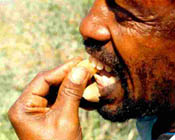Scientific name
Ficus vasta1
Family name
Moraceae
Local name(s)
Warka (Amargna), Maraito (Afargna), Daero (Tigrigna)
General description
F. vasta is a very large tree growing over 25m tall with spreading rounded crown. Trunk is often buttressed, occasionally an epiphyte. The bark is smooth and grey. Young branches are thick, with soft dense hairs, 5 - 12mm, yellow-white-brown, skin flaking when dry. Leaves are quite stiff, elliptic, rough to the touch, almost circular 8-25 x 4-23cm, tip rounded but often with a blunt point, base rounded, heart-shaped, leaf stalk 3-12cm, hairy. Leaf stalk is hairy below with well-marked veins, the 2 outer veins reaching up to the middle of the leaf, all forked clearly at the edge. Globosely figs are up to 2cm in diameter and hanging in clusters from the branches. They are green with pale spots when ripe, hairy, the opening clear.
Edible part(s), preparation methods and palatability
Fruits are edible. Fruits are consumed in normal and in food shortage periods. Mostly the fruits are being collected by children who are able to climb the tree. Goats, monkeys, baboons, sheep and birds all like the fruits from this tree. The fruits are either eaten raw or when half or completely dry, no preparation is necessary. When the fruits are dry, they can be stored and eaten stewed when there is need. In its wild stage F. vasta can provide food in food shortage periods.
Agroecology
F. vasta is a fig tree of dry north and eastern Africa, the Sudan, Ethiopia, Somalia, Saudi Arabia and into Uganda and Tanzania. The tree is found along rivers and in dry savannah, often forming stands or thickets and grows in mid- and highland areas (1,400 – 2,500m). The species is not being domesticated and is slowly disappearing from the Ethiopian landscape due to firewood scarcity which is heavily affecting all big tree species alike.
Propagation method(s)
Propagates by cuttings, seedlings and wildlings. The seeds are produced in figs in large numbers. The can be extracted and dried. No treatment necessary and can be stored up to two months.
Sample location(s)
(1) Mekane Birhan, Jana Mora Woreda, North Gonder; (2) Ibnat, South Gonder; (3) Belessa, North Gonder
Remarks
Other uses of the species are firewood, timber for utensils, furniture and carvings.
1 |

















